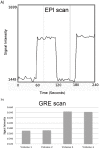A Rotational Cylindrical fMRI Phantom for Image Quality Control
- PMID: 26625264
- PMCID: PMC4666484
- DOI: 10.1371/journal.pone.0143172
A Rotational Cylindrical fMRI Phantom for Image Quality Control
Abstract
Purpose: A novel phantom for image quality testing for functional magnetic resonance imaging (fMRI) scans is described.
Methods: The cylindrical, rotatable, ~4.5L phantom, with eight wedge-shaped compartments, is used to simulate rest and activated states. The compartments contain NiCl2 doped agar gel with alternating concentrations of agar (1.4%, 1.6%) to produce T1 and T2 values approximating brain grey matter. The Jacard index was used to compare the image distortions for echo planar imaging (EPI) and gradient recalled echo (GRE) scans. Contrast to noise ratio (CNR) was compared across the imaging volume for GRE and EPI.
Results: The mean T2 for the two agar concentrations were found to be 106.5±4.8, 94.5±4.7 ms, and T1 of 1500±40 and 1485±30 ms, respectively. The Jacard index for GRE was generally found to be higher than for EPI (0.95 versus 0.8). The CNR varied from 20 to 50 across the slices and echo times used for EPI scans, and from 20 to 40 across the slices for the GRE scans. The phantom provided a reproducible CNR over 25 days.
Conclusions: The phantom provides a quantifiable signal change over a head-size imaging volume with EPI and GRE sequences, which was used for image quality assessment.
Conflict of interest statement
Figures







References
MeSH terms
LinkOut - more resources
Full Text Sources
Other Literature Sources
Medical

